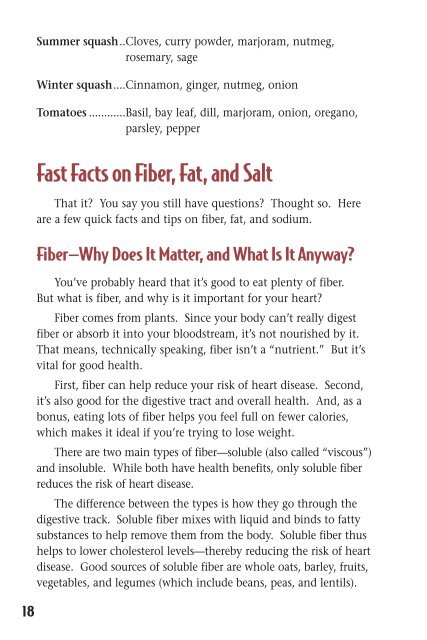Keep the Beat: Heart Healthy Recipes - National Heart, Lung, and ...
Keep the Beat: Heart Healthy Recipes - National Heart, Lung, and ...
Keep the Beat: Heart Healthy Recipes - National Heart, Lung, and ...
You also want an ePaper? Increase the reach of your titles
YUMPU automatically turns print PDFs into web optimized ePapers that Google loves.
Summer squash..Cloves, curry powder, marjoram, nutmeg,<br />
rosemary, sage<br />
Winter squash....Cinnamon, ginger, nutmeg, onion<br />
Tomatoes ............Basil, bay leaf, dill, marjoram, onion, oregano,<br />
parsley, pepper<br />
18<br />
Fast Facts on Fiber, Fat, <strong>and</strong> Salt<br />
That it You say you still have questions Thought so. Here<br />
are a few quick facts <strong>and</strong> tips on fiber, fat, <strong>and</strong> sodium.<br />
Fiber—Why Does It Matter, <strong>and</strong> What Is It Anyway<br />
You’ve probably heard that it’s good to eat plenty of fiber.<br />
But what is fiber, <strong>and</strong> why is it important for your heart<br />
Fiber comes from plants. Since your body can’t really digest<br />
fiber or absorb it into your bloodstream, it’s not nourished by it.<br />
That means, technically speaking, fiber isn’t a “nutrient.” But it’s<br />
vital for good health.<br />
First, fiber can help reduce your risk of heart disease. Second,<br />
it’s also good for <strong>the</strong> digestive tract <strong>and</strong> overall health. And, as a<br />
bonus, eating lots of fiber helps you feel full on fewer calories,<br />
which makes it ideal if you’re trying to lose weight.<br />
There are two main types of fiber—soluble (also called “viscous”)<br />
<strong>and</strong> insoluble. While both have health benefits, only soluble fiber<br />
reduces <strong>the</strong> risk of heart disease.<br />
The difference between <strong>the</strong> types is how <strong>the</strong>y go through <strong>the</strong><br />
digestive track. Soluble fiber mixes with liquid <strong>and</strong> binds to fatty<br />
substances to help remove <strong>the</strong>m from <strong>the</strong> body. Soluble fiber thus<br />
helps to lower cholesterol levels—<strong>the</strong>reby reducing <strong>the</strong> risk of heart<br />
disease. Good sources of soluble fiber are whole oats, barley, fruits,<br />
vegetables, <strong>and</strong> legumes (which include beans, peas, <strong>and</strong> lentils).

















